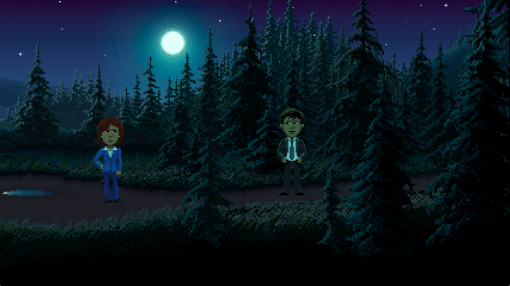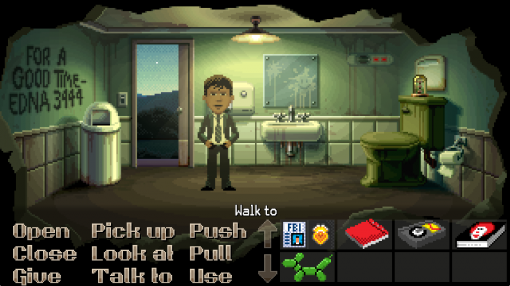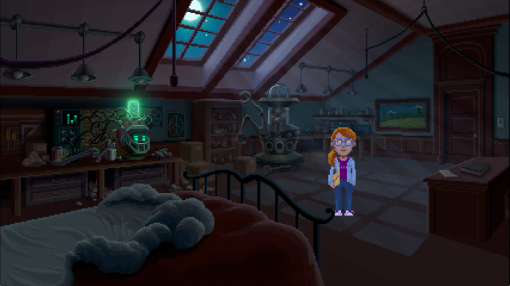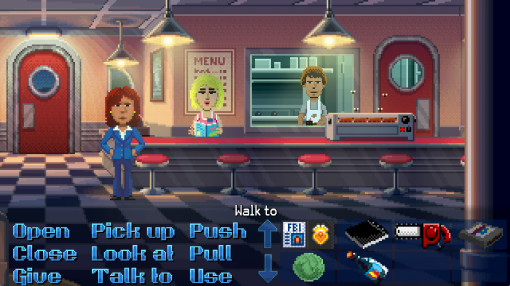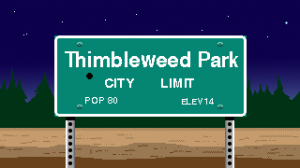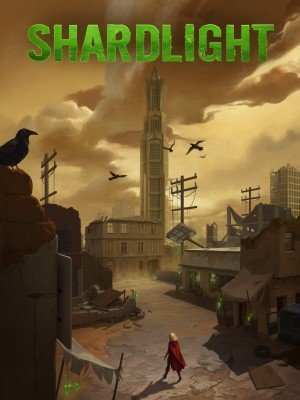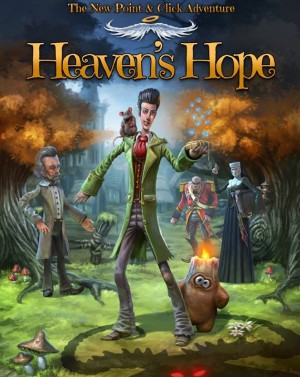Thimbleweed Park hands-on archived preview

They say the more things change, the more they stay the same, and nowhere is that more true than in the adventure genre.
Way back in 1987, a couple dudes no one had ever heard of named Ron Gilbert and Gary Winnick came up with a pioneering game called Maniac Mansion, which introduced multiple playable protagonists and a funky verb-based, point-and-click interface called SCUMM. Three decades later, a couple dudes everyone has now heard of are coming out with a retro-styled game called Thimbleweed Park, with a new set of multiple playable protagonists and a more refined but still-funky and essentially identical verb-based, point-and-click interface. As the game itself boasts, this is meant to be “the best adventure game you never played in 1987.”
Yes, Thimbleweed Park is Gilbert and Winnick’s answer to the hue and cry of old-school adventure gamers who miss the golden era of rich player interaction, expansive open-world environments to explore, overlapping objectives, unique characters to converse with, and a serious lack of hand-holding. Hotspot highlighter? Pshaw! Hint system? Who needs it! Single-click smart cursor? Puh-leeeze! That’s all for wimpy modern gamers who didn’t cut their teeth on the try-everything-on-everything (as a last resort) school of puzzle design and still fondly remember calls to help hotlines in the pre-walkthrough era. (And while I’m at it… get off my lawn!)
But wait a second, you may be thinking. Who wants to go back to hideously chunky pixels, rudimentary animation, and a rough-around-the-edges control scheme of an earlier millennium? Not to worry, as one of the developers’ other stated goals for Thimbleweed Park is not to give players the same experience they had back then, but the experience they remember having. (We recall most of the good stuff from the best games, and forget or excuse most of the bad, do we not?) There are still pixels in this game, sure, but man, are they beautiful here in all their high-resolution glory. Whether it’s the gradient colouring of a blue, pink, and orange-tinted sunset vista; the myriad little animations peppering each screen like feet splashing in water and stars twinkling in the night sky; or the sheer attention to detail packed into libraries, shops, and cemeteries, this is a great looking adventure. Normally this is where I say that Game X’s graphics likely won’t win over any ardent naysayers, but not this time. Thimbleweed Park may just convert its fair share of eye candy lovers.
The game (more or less) begins with a murder investigation, as two detectives arrive at the scene of the crime, unbeknownst to the other. According their personal journals, plucky Junior Special Agent Antonio Reyes and grizzled, snarky Senior Special Agent Angela Ray both have their own secret reasons for pursuing a case in the middle of nowhere, so they quickly split up. Surprisingly, you can’t have them interact with each other, except to exchange inventory, but you can usually switch back and forth between them as playable protagonists at will.
Anyone who develops carpal tunnel symptoms even thinking about the click-heavy SCUMM interface can rest assured that Thimbleweed Park isn’t without its user-friendly features. There are double-click and click-hold options to run, which is useful given the amount of scrolling terrain you’ll need to cover. While left-click performs most of the actions, the right mouse button is assigned to the most logical first action (highlighted in the verb list) for any given hotspot. Usually that’s simply “look”, but sometimes it’s a bit more impactful than that. But don’t think you can lazily right-click your way entirely through the game, as there will still be additional commands required in certain important instances. That’s where the verbs come in, and though there are a fair number of canned responses for non-matching actions, the added freedom to experiment with the generously high number of hotspots means there’s plenty to mess around with before even digging into the puzzles.
It’s a good thing, too, as the puzzles I encountered certainly weren’t gimmes. I acquired many items in my travels, some of which I never found a use for (and suspect I may never, though that remains to be seen), and others that demanded a fairly creative application. Where the difficulty comes in, though, is not simply the sheer volume of objects, but the enormous number of possibilities across a wide range of locations. In the middle of town I came across a wrench I figured I’d need, but failing to purloin it right away, I decided I’d come back to it later. A little while after, I stumbled upon a clue to the solution, but since there was still so much to explore, I kept going instead of circling back right away. And without a word of exaggeration, it was an hour later before I returned to the wrench. That wasn’t an hour filled with wasted padding either, but a busy 60 minutes crammed with all kinds of adventurey stuff.
Part of that time was spent playing two entirely different characters than the pair I initially started with. In questioning the townsfolk, twice I was thrust into flashback sequences of possible suspects. One had me playing Ransome the clown, a hard-swearing, Krusty lite-style circus performer complete with poofy red hair, ball nose, squeaky shoes and white makeup. The other had me playing a computer geek and videogame developer wannabe named Delores. Each had their own distinct areas, inventory, and puzzles, but even those proved to be remarkably extensive. Thank goodness each character has a handy to-do list tucked away in inventory.
All that may sound great, and it is, but I haven’t even gotten to the best part of Thimbleweed Park, which is its utterly unique sense of place. So many adventures treat their settings as generic, interchangeable backdrops, but there’s a reason this game was named after the geographically unspecified but vaguely southern (fictional) American town and its population of 81. (*BANG!* Make that 80.) It’s a seemingly normal rural town on the surface, but everything is just a little off. Local businesses are boarded up, the radios are all tuned to a conspiracy-themed station interrupted by frequent alerts, and technology is ruled by inventions from the beloved but recently-deceased Chuck. Need a fingerprint match? Run it through the talking FingerTron 3000 arcade-style cabinet. Got a blood sample to analyze? The BloodTron 3000 is your answer. You can’t even take down a culprit without first running the evidence through the ArrestTron 3000. (Hey, Chuck was an inventor, not a wordsmith.)
The local populace is just as wonderfully bizarre, from the “signal”-obsessed, bird-costumed plumbing sisters who call themselves the Pigeon Brothers to the eerily similar sheriff and coroner whose only obvious difference is their quirky tendency to finish words with “a-reno” or “a-hoo”, respectively. I wasn’t motivated so much by the whodunit nature of the murder case as I was by simply figuring out what the heck was going on with this strange town and its oddball inhabitants. The only thing overtly unreal is the curse put on Ransome by a vindictive voodoo lady, but just about everything has a slightly surreal vibe, and it won’t be long into your investigation before that starts to manifest itself into something more sinister.
Despite the ostensibly serious stakes and occasionally ominous tone, the trademark Gilbert humour is fully evident as well. Thimbleweed Park is laced with dry little quips that are genuinely funny, though I was less amused by the broader, fourth wall-breaking remarks. The first reference to the corpse starting to pixelate was worth a chuckle, but the novelty wore off before the jokes did. (But hey, I guess if we’re going old-school, some self-referential gags come with the territory.) All of it is delivered by a skillful voice cast, highlighted by the cantankerous Ransome and the hardened, cynical Agent Ray who’s never shy about voicing disdain for her unwanted partner. Some of the characters have names you might recognize, like Sandy and Dave, owners of the S&D Diner now serving fly-attracting, puke-inducing hotdogs. In fact, there are so many clever nudge-wink callbacks to Maniac Mansion, this game feels more like its spiritual successor than Day of the Tentacle ever did. (But shhh… don’t tell LucasArts.)
Okay, I haven’t even mentioned the fantastic music that transitions easily from southern-noir guitar to jaunty carnival tunes, but it’s time to wrap up, as this is starting to feel more like a full-fledged review than a first-look sneak peek. Then again, I spent more time playing through the Thimbleweed Park press demo than I have on many other complete games! You remember way back when adventures used to be LONG? So do Ron Gilbert and Gary Winnick. I was told that the preview version represented about 15% of the full game, so I figured I could breeze through it quickly, only to discover four hours later just how wrong I was. I’ll let you do the math, but it’s clear that Thimbleweed Park is going to be a substantial game, the likes of which rarely come around anymore. You could cut down on play time by selecting the “casual” mode that makes some of the puzzles easier, but the “normal” setting is anything but a walk in the (figurative) park.
The full game is coming soon, and if the rest can match the stellar quality and quantity of the opening chapters when it releases, investigating Thimbleweed Park will be time very well spent, and a refreshing reminder that sometimes they still make ‘em like they used to.




